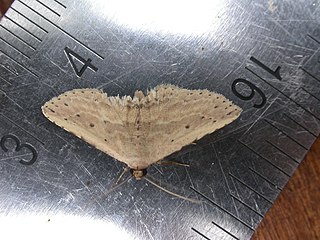Filisignella is a monotypic moth genus in the family Gelechiidae erected by Anthonie Johannes Theodorus Janse in 1951. Its only species, Filisignella cirrhaea, was first described by Edward Meyrick in 1914. It is found in South Africa.
Euonychodes is a monotypic moth genus of the family Noctuidae. Its only species, Euonychodes albivenata, is found in South Africa. Both the genus and species were first described by Warren in 1914.

Hyposada is a genus of moths of the family Erebidae.

Plecopterodes is an Afrotropical genus of moths of the family Erebidae.
Erastria is a genus of moths in the family Geometridae, found primarily in tropical and subtropical climates in Africa and Asia. The genus was erected by Jacob Hübner in 1813.
Xenimpia is a genus of moths in the family Geometridae. It was described by Warren in 1895.
Xenochroma is a genus of moths in the family Geometridae.

Callopistria latreillei, Latreille's Latin, is a moth of the family Noctuidae. The species can be found in the Palearctic realm, most parts of Europe, Asia, and in Africa from Egypt to South Africa. The habitat consists of rocky limestone slopes with deciduous woodland.

Asthenotricha dentatissima is a moth in the family Geometridae. It was described by William Warren in 1899. It is found in the Democratic Republic of the Congo, Kenya, South Africa, Tanzania and Uganda.
Asthenotricha inutilis is a moth in the family Geometridae first described by William Warren in 1901. It is found in Cameroon, the Democratic Republic of the Congo, Kenya, South Africa, Tanzania and Uganda.
Asthenotricha serraticornis is a moth in the family Geometridae first described by William Warren in 1902. It is found in the Democratic Republic of the Congo, Kenya, Malawi, South Africa, Tanzania and Uganda.

Condica viscosa is a species of moth in the family Noctuidae. It was described by Christian Friedrich Freyer in 1831. It is found from southern Europe and North Africa to Arabia and the southern parts of western Asia. The habitat consists of lowland areas near the coast, including dry slopes, road side verges, dry river beds or fallow land.

Zamarada metallicata is a moth of the family Geometridae first described by William Warren in 1914.
Stilbosis antibathra is a moth in the family Cosmopterigidae. It was described by Edward Meyrick in 1914. It is found in Pretoria, South Africa.
Compsoctena autoderma is a moth in the family Eriocottidae. It was described by Edward Meyrick in 1914. It is found in South Africa and Zimbabwe.
Compsoctena dermatodes is a moth in the family Eriocottidae. It was described by Edward Meyrick in 1914. It is found in South Africa, Tanzania and Zimbabwe.
Compsoctena microctenis is a moth in the family Eriocottidae. It was described by Edward Meyrick in 1914. It is found in South Africa, Tanzania and Zimbabwe.
Dichomeris torrefacta is a moth in the family Gelechiidae. It was described by Edward Meyrick in 1914. It is found in South Africa.
Scrobipalpa cretigena is a moth in the family Gelechiidae. It was described by Edward Meyrick in 1914. It is found in South Africa.
Stomopteryx cirrhocoma is a moth of the family Gelechiidae. It was described by Edward Meyrick in 1914. It is found in South Africa.





